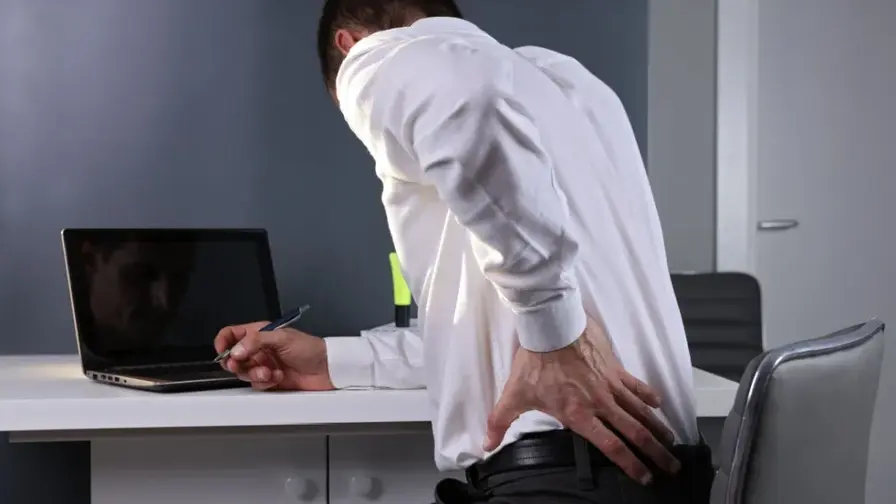The author of "Hunter", Yoshihiro Togashi, has been suffering from back pain for a long time! Medical warning: If not treated in time, it may lead to "intervertebral disc herniation"

Recently, the fast-food restaurant company and the well-known anime “Hunter x Hunter” jointly launched a card set, which aroused widespread discussion among fans. In fact, the author of “Hunter”, Yoshihiro Togashi, has been suffering from back pain for a long time. Since the manga was serialized, it has been suspended many times, and it was not until recently that it was announced that it would be restarted. Yoshihiro Togashi once said on social media that even when he squats on the toilet, his waist reaches his waist, and he can only relieve his back pain by painting while lying down.
The author of “Hunter” has been suffering from back pain for a long time! If not treated in time, it may lead to “intervertebral disc herniation”
Could it be that Yoshihiro Togashi’s long-term back pain could lead to a more serious “disc herniation”? Dr. Liu Zhewei, an attending physician at the Department of Orthopedics at Cathay General Hospital, pointed out that intervertebral disc herniation is a common spinal problem, which means that the nucleus pulposus of the intervertebral disc protrudes or squeezes into the surrounding nerve structures, causing severe inflammation of the waist. For those who have long-term low back pain, it is easy for the intervertebral disc to lose water due to degeneration, worsening the original low back pain, sciatica and other related symptoms.
Dr. Liu Zhewei said that the most common form of intervertebral disc herniation is lumbar spondylosis. The main symptoms include waist pain, lower back pain, and even radiating pain that radiates to the buttocks and the back of the thigh. Severe cases may lead to blunting of the affected area, weakness of the lower limbs, incontinence, paralysis, sciatica and other conditions. Generally speaking, risk groups include the elderly, those with genetics, those who are obese, those who sit for long periods of time, those who carry goods (occupation), and those who have suffered severe trauma.
I endured long-term back pain for 7 years without seeking medical treatment! His disc herniation led to “nerve stenosis”
If a herniated disc is not treated in time, may it face more serious consequences? Dr. Liu Zhewei cited the case of a 55-year-old male in the clinic: Unfortunately, the patient suffered a back injury due to an accident 7 years ago. The patient decided to seek medical treatment after experiencing severe back pain, sciatica, numbness and being unable to walk. After undergoing an MRI, it was discovered that the intervertebral disc of the fifth lumbar vertebrae and the first sacral vertebra had herniated, but no surgical treatment was carried out in time.
The patient received conservative treatment such as rehabilitation and medication. Although the pain slowed down within a few months, it never disappeared; the pain lasted for 7 years. During this period, the patient tried a variety of treatments, including waist stretching, local electrotherapy injections, and thermocoagulation therapy, but none could completely relieve the pain. The patient’s condition has become worse recently. He can hardly walk and needs to sit down and rest after walking 50 meters. After another MRI examination, it was discovered that the disc herniation from 7 years ago had never disappeared. Instead, it gradually caused compression of the spinal canal after the acute stage and evolved into nerve stenosis.
It should be noted that not only the middle-aged and elderly people are at risk of disc herniation. Dr. Liu Zhewei explained that intervertebral disc herniation caused by degeneration is mostly caused by long-term poor posture and improper force application, and is indeed common in middle-aged and elderly people. Sudden disc herniation is more common in middle-aged and middle-aged people aged 20-50 years old. It is caused by improper exertion of force when lifting heavy objects, poor posture, or slipping to the waist.
Does a herniated disc necessarily require surgery? Doctor: If it has affected your bowel and bladder, don’t delay it any longer.
How to treat intervertebral disc herniation? Dr. Liu Zhewei explained that “rehabilitation exercise” is one of the important therapies for the recovery of intervertebral disc herniation. Help reduce pain, strengthen supporting muscle groups, and improve body posture through appropriate exercise. Common rehabilitative exercises include stretching, strengthening, and core stability exercises.
In addition, “drug therapy” is usually used to relieve pain and reduce inflammation. Clinically, non-steroidal anti-inflammatory drugs, muscle relaxants, and even specific antispasmodics may be recommended to relieve the symptoms of neuralgia. In mild disc herniation, part of the disc may be broken down and absorbed by white blood cells to relieve symptoms.
In more serious cases, if the pain does not improve after rehabilitation, or even worsens or affects the bowel and bladder function and lower limb motor function, surgery may be necessary or even an emergency option. Intervertebral disc herniations that have reached 50% stenosis in the spinal cord cavity are often unable to be effectively decomposed and absorbed to gradually relieve symptoms and evolve into symptoms of chronic nerve compression and nerve stenosis, seriously affecting the patient’s walking function and even causing chronic nerve root disease.
Surgical options for herniated disc? What is the difference between minimally invasive surgery and traditional surgery?
Dr. Liu Zhewei pointed out that the purpose of surgical treatment is to reduce the pressure that compresses the nerves. Currently, traditional surgery and endoscopic partial discectomy can be used to achieve the effect of decompression. Endoscopic decompression is currently the mainstream method of minimally invasive spinal surgery: an incision of about 1 cm in size is made on the affected area, and through a high-magnification endoscope, the details of red blood cells passing through the microvessels in the blood vessels above the nerves can be clearly seen.
High-magnification endoscopy can help remove adhesions caused by chronic compression during surgery to avoid nerve damage. Dr. Liu Zhewei emphasized that although endoscopic surgery has smaller wounds, it can use the control of flexible lenses to provide a more diverse field of view than traditional surgery, increase the completeness of spinal decompression, reduce damage to spinal joints, and avoid spinal acceleration. degradation. In addition, compared with traditional surgery or general minimally invasive surgery, the wound of this surgery is smaller and the recovery period is shorter. Patients are expected to return to normal life as soon as possible.
Long-term nerve compression has made it difficult for him to even walk. After the operation, he said: “My waist has never been so relaxed.”
Dr. Liu Zhewei said that the above-mentioned patient finally underwent spinal endoscopic surgery to peel off nerve adhesions and intervertebral discs, and release the nerve roots that had been compressed by years. The next day after the operation, he complained that “his waist and lower limbs have not felt so relaxed for a long time.” His sciatica symptoms were also significantly relieved. However, due to poor walking caused by long-term nerve compression, muscle atrophy requires further improvement through rehabilitation and core muscle training.
Finally, Dr. Liu Zhewei reminded the public that lumbar disc herniation is a common spinal disease and can generally be improved through conservative treatment. However, it is still recommended that careful evaluation is required to avoid severe chronic compression of nerves, which may lead to chronic disability. In addition, if it is found that the intervertebral disc herniation has not healed for a long time after conservative treatment, you should discuss with the attending physician as soon as possible whether to perform surgical treatment to avoid worsening of the condition.
Further reading:





